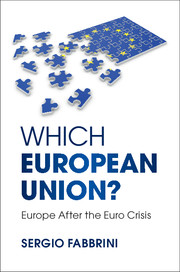Book contents
- Frontmatter
- Dedication
- Contents
- List of boxes
- List of figures
- List of tables
- List of abbreviations
- Preface – How many unions?
- Acknowledgments
- Part I Institutionalization of multiple unions
- 1 From Rome to the Lisbon Treaty
- 2 The Lisbon Treaty and the euro crisis
- 3 Institutionalization and constitutional divisions
- Part II Main perspectives on the European Union
- Part III Towards the compound union perspective
- Appendix
- Glossary
- References
- Index
1 - From Rome to the Lisbon Treaty
Published online by Cambridge University Press: 05 March 2015
- Frontmatter
- Dedication
- Contents
- List of boxes
- List of figures
- List of tables
- List of abbreviations
- Preface – How many unions?
- Acknowledgments
- Part I Institutionalization of multiple unions
- 1 From Rome to the Lisbon Treaty
- 2 The Lisbon Treaty and the euro crisis
- 3 Institutionalization and constitutional divisions
- Part II Main perspectives on the European Union
- Part III Towards the compound union perspective
- Appendix
- Glossary
- References
- Index
Summary
Introduction
The EU is the result of the evolution and transformation of a historic agreement among, first, Western European nation states and then the Western and Eastern plus the Southern parts of Europe, aimed above all at bringing to a close a long sequence of hot and cold wars. This aim was entrusted to the formation of a common and then single market able to bring economic and social security to European states. European integration has been the response to the trauma and demons of the two halves of the twentieth century. The moral source of European integration resided in the need to avoid further wars and ideological divisions on the continent. After the 1954 failure of the more ambitious project of setting up a European Defence Community (EDC), its success has been dependent, on the military side, on the protection of the North Atlantic Treaty Association or NATO, while, on the economic side, it has rested on the formation and enlargement of a common and then single market. The EU is the outcome of choices made by national elites and supranational actors for peacefully aggregating nation states of different demographic size, historical identity and political cultures. The crucial choices were made at critical junctures, as in the first half of the 1950s, in the first years of the 1990s and then at the start of the 2010s.
Monnet (1978: 46) wrote in his Memoirs that “I have always believed that Europe would be built through crises and that it would be the sum of their solutions.” This means that the EU is the sum of the choices taken by actors with decision-making power in those crisis periods conceptualized as critical junctures. Critical junctures are windows of opportunity for pursuing new aims (Pierson and Skocpol 2002). In those moments, the path-dependent logic is suspended and different options potentially become available.
- Type
- Chapter
- Information
- Which European Union?Europe After the Euro Crisis, pp. 3 - 32Publisher: Cambridge University PressPrint publication year: 2015



